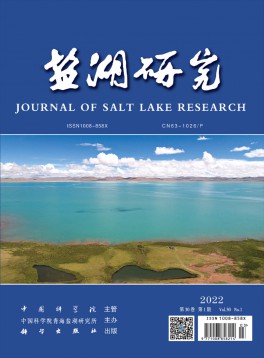Formation of Li Salts from Natural Brines during Isothermal Evaporation at 25℃
關(guān)鍵詞:forrmation of li salts isothermal
摘要:Li brines are the primary resources for Li salt industries.Evaporation is necessary to concentrate Li due to its low level of concentration in raw brines.The salt sequences during the evaporation of Li brines,especially the behavior of Li salts,represent key data for solar technologies.However,chemists cannot use any phase diagram to estimate Li salt sequences during evaporation at 25℃.The thermodynamic model proposed by us in 2003 represents the only tool for the prediction of equilibrium conditions during the evaporation of solutions containing Li^+,Na^+,K^+,Mg^2+/Cl^-,SO4^2-,and-H2O components at 25℃.In this paper,the predicted salt sequences of 20 brines are reported.The results indicate that (1) the first crystallized Li salt during evaporation of Li brine varies in brine composition;(2) lithium sulfate is crystallized in many cases initially for brines of magnesium sulfate subtype,while Db4 (Li2SO4 ·K2SO4 ) or Db3 (2Li2SO4 ·Na2SO4 ·K2SO4 ) appears first for sodium sulfate and magnesium sulfate subtypes with lower Mg/Li composition,and the final eutectic point is H+LiC+Lc+Ls+Car;(3) the final eutectic point is H+LiC+Lc+Car for brines of chloride type;and (4) Li content corresponding to the first crystallized Li salt is in the range of 0.43%-1%.These findings enhance our knowledge of Li chemistry and provide insights into solar pond technology of the Li-brine process.
鹽湖研究雜志要求:
{1}來稿請(qǐng)注明通訊地址、單位、郵編、電話等,本刊一律不退稿,請(qǐng)自留底稿。
{2}文稿應(yīng)具有先進(jìn)性、科學(xué)性、邏輯性和實(shí)用性。要求資料完整、可靠,觀點(diǎn)明確,文字精煉,層次清楚,數(shù)據(jù)準(zhǔn)確并經(jīng)過統(tǒng)計(jì)學(xué)處理。
{3}題名。題名一般不宜超過20個(gè)漢字,應(yīng)緊扣文章主題,用語用詞嚴(yán)謹(jǐn)規(guī)范且利于網(wǎng)絡(luò)檢索。不得使用非公知公用、同行不熟悉的外來語、縮寫詞、符號(hào)和代號(hào)。
{4}參考文獻(xiàn):參考文獻(xiàn)采用順序編碼制,參考文獻(xiàn)的序號(hào)以方括號(hào)加注于被注文字的右上角,內(nèi)容按序號(hào)順序排列于文后,序號(hào)用方括號(hào)標(biāo)注,按正文中出現(xiàn)的次序標(biāo)引,文后沒有與文中引用相對(duì)應(yīng)的參考文獻(xiàn)一律刪除。
{5}來稿請(qǐng)附中英文摘要(中文200—300 字左右)和關(guān)鍵詞(3—5 個(gè))。
注:因版權(quán)方要求,不能公開全文,如需全文,請(qǐng)咨詢雜志社

